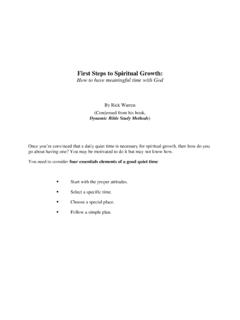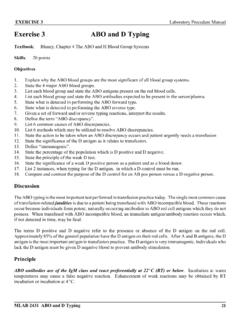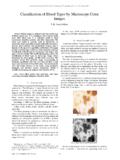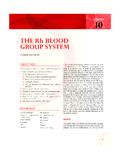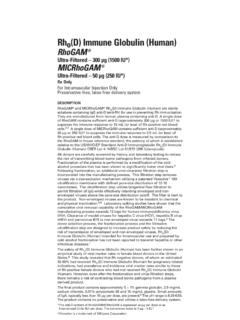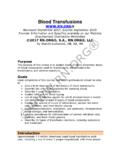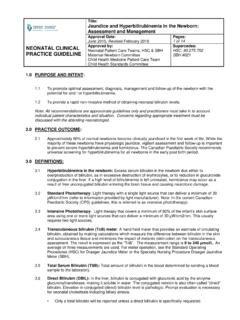Transcription of Simulated Blood Typing Whodunit Lab Activity Student …
1 Ln the tes. ins (Anti ns are ~lasrna. I substa surface Simulated Blood Typing Whodunit Lab Activity Student Study Guide BACKGROUND ABOIRh Blood System Around 1900, Karl Landsteiner discovered that there are at least four different kinds of human Blood , determined by the presence or ab- sence of specific agglutinogens (antigens) on the surface of red Blood cells (erythrocytes). These antigens have been designated as A and B. Antibodies against antigens A or B begin to build up in the Blood plasma shortly after birth, the levels peak at about eight to ten years of age, and the antibodies remain, in declining amounts, throughout the rest of a person's of life.)
2 The stimulus for antibody production is not clear; however, it has been proposed that antibody production is initiated by minute amounts of A and B antigens that may enter the body through food, bacteria, or other means. Humans normally pro- duce antibodies against those antigens that are not on their erythro- cytes: A person with A antigens has anti-B antibodies; a person with B antigens has anti-A antibodies; a person with neither A or B anti- gens has both anti-A and anti-B antibodies; and a person with both A and B antigens has neither anti-A nor anti-B antibodies.
3 Blood type is based on the antigens, not the antibodies, a person possesses. The four Blood groups are types A, B, AB, and 0. Blood type 0, char- acterized by the absence of A or B agglutinogens, is the most common in the United States, in 45% of the population. Type A is next in fre- quency, found in 39% of the population. The incidences of types B and AB are 12% and 4% respectively. In 1940, Landsteiner and Wiener discovered another group of anti- gens on the surface of red Blood cells called Rh factors. They are called Rh factors because they were first found in Rhesus monkeys.
4 An individual who possesses these antigens is designated Rh+ and an individual who lacks them is designated Rh-. Unlike the ABO system, antibodies to the Rh factors are not normally present in the plasma, but are produced upon exposure to Rh factors. Exposure to Rh factors can occur during Blood transfusions (if Rh+ Blood is transfused to an Rh- recipient), or when an Rh- mother carries an Rh+ fetus. bodies): nces of Copymanta. Pamission graated to make unlimited qis for usa in any me school building For educsdmal use mly. Not for mmmadal use or resale.
5 1 8 2002 WARD'S Natnral Science Establishment AU Rights Reserved 250-1090 IYVVY: pan of a : 120 day Figure 1 Antibodies Can Give Can Receive in Plasma Blood To Blood From Neither Anti-A nor Anti-B 0 Neither A nor B Both Anti-A and Anti-B There is a simple test to determine Blood type, performed with antis- era containing high levels of anti-A, anti-B and anti-Rh agglutinins. Several drops of each kind of antiserum are added to separate sam- ples of Blood . If agglutination (clumping) occurs only in the suspen- DID YOU KXTnTA'* sion to which the anti-A serum was added, the Blood type is A.
6 If ag- red glutination occurs only in the anti-B mixture, the Blood type is B. Ag- glutination in both samples indicates that the Blood type is AB. The absence of agglutination in any sample indicates that the Blood type is 0. Any sample that agglutinates in the presence of anti-Rh serum is considered Rh+. Agglutination Reaction of ABO Blood - Typing Sera Reaction Anti-A Serum Anti-B Serum Agglutination No Agglutination No Agglutination No Agglutination No Agglutination M make unlimited copies for use in my me school building For edudmal use only.
7 Not for wmmerdal use or resale. I 6 2002 WARD'S Natural Science Establishment All Rights Reserved - DII present. 1 YOU K tlnnrl m ed Blood sma in c cells. TI ?ere lod, dies Importance of Blood Typing As noted in the table above, people can receive transfusions of only certain Blood types, depending on the type of Blood they have. If in- compatible Blood types are mixed, erythrocyte destruction, agglutina- tion and other problems can occur. For instance, if a person with Type B Blood is transfused with Blood type A, the recipient's anti-A antibodies will attack the incoming type A erythrocytes.
8 The type A erythrocytes will be agglutinated, and hemoglobin will be released into the plasma. This problem may not be serious, unless a large amount of Blood is transfused. Blood type, an inherited characteristic, may also be used in medico- legal situations involving identification of disputed paternity. A com- exclude the man as a possible parent. Blood Typing does not prove that an individual is the faker of a child; it merely indicates whether or not he is a possible parent. For example, a child with a Blood type of AB, whose mother is type A, could not have as a father a man whose Blood type is 0.
9 Whenever Blood has been shed in a criminal act, the identification and Typing of the Blood stains are of primary importance to the crime scene investigator. The ABO Blood groups are used to screen out pos- sible suspects involved in the crime. The first step in the investigation is to distinguish the bloodstains from other similar looking com- pounds such as fruit juices, jam, chemicals, paint, et~. Secondly, along with a number of sophisticated tests to determine the sex of the indi- vidual from which the Blood came, and the age of the Blood stain, a simple Blood Typing test is also performed.
10 Although a positive match of the suspect's Blood type is not sufficient to convict someone of a crime, it is one type of evidence that is often obtained during a crime investigation. Copymnter. Permission granted to make unlimited copies for use in any me I school buildin& For edutatioal Not for commercial w or resale. I 8 2002 WARD'S Natural Science Establishment AH Rights Reserved 3arnels a: he only wal red 1: b YOU K nd their mamrr >load cel f 1 NOW? relatives lals hav Ls. Assume the role of a forensics lab technician Examine suspected Blood evidence found at a crime scene Confirm that the evidence is real Blood Perform the ABO/Rh procedure to determine the Blood type Relate the evidence to four possible suspects are MATERIALS MATERIALS NEEDED PER GROUP 4 Pieces of stained cloth squares 6 Blood Typing trays 18 Toothpicks 1 Microscope slide 1 Compound microscope SHARED MATERIALS 1 Vial, WARD'S Simulated Blood - Victim's Blood 1 Vial, WARDS Simulated Blood - Suspect #1 1 Vial.
